Abstract
Despite concerted efforts by the Malaysian government over the years to promote recycling through various campaigns, little has been achieved due to poor participation of the public. As an incentive to make recycling a habit among Malaysians, the Malaysian government implemented the waste separation at source programme which makes it mandatory for waste to be sorted into different categories prior to disposal. This paper assesses the performance of household recycling activities prior to and after the implementation of the separation at source programme among households in Putrajaya, Malaysia. The study also to assess the respondents’ awareness and utilization of available drop-off centres recycling facilities. A Face-to-face survey was employed to collect data from 431 randomly selected households in Putrajaya. The study found considerable and statistically significant improvement in waste separation activities of the households after the implementation of the separation at source programme. Meanwhile, those who fail to separate their waste gave reasons such as too busy, no time, not interest, lack of enforcement and lack of appropriate facilities. In terms of awareness and utilization of drop-off centres, a considerable number of respondents indicated being aware of available drop-off centre (86%), but only an insignificant proportion of the respondent utilized the facilities. Fruitful recycling policy recommendations based on the finding were suggested.
Keywords: “Recycling”“Household Separation at Source”“Drop-Off”“Waste Management”“Malaysia”
Introduction
Malaysia like many other developed and developing countries is faced with the problem of dealing with the continuous rise in the amount of daily generation of waste. Widespread environmental damage and negative impact on human health as well as loss of valuable resources with great economic value are widely reported consequences of poor management of waste. With an estimated population of over 32 million as at 2017 (DOS, 2017), Malaysian generates 33,000 tons of domestic waste per day, exceeding the projected production of 30,000 tons by the year 2020 (SWcorp, 2015). Estimated kg/person/day was 0.85 (Zainu & Songip, 2017) compared to 0.7 kg/person/day in 1987 (Jusoh, 2002).
The increased generation of waste is reported to be associated with rapid urbanization and significant advancement in standard of living (Moh & Abd Manaf, 2017; Murad & Siwar, 2007). Given the increasing amount of daily generation of waste, landfills which are the most commonly used means of waste disposal in the country are fast reaching their threshold, while others have reached their maximum capacity. On the other hand siting new landfills are challenging due to the increasing populace awareness on its negative externality and increasing opportunity cost for land resulting from population growth and urbanization. Besides the problems associated with landfill disposal, waste collection and disposal has increasingly consumed a large proportion of many cities budgets. The Malaysia government spends approximately RM 2 billion annually to provide solid waste management (SWM) services (New Straits Times, Sept. 2015), thus, taking up about 60% of Local Authority budget (Agamuthu & Fauziah, 2011; Masirin, Idrus, Ridzuan, & Mustapha, 2008).
The increasing rate of solid waste generation and its adverse effect requires an integrated solid waste management which incorporates waste prevention prior to generation and its management after generation which is encouraged through reduce, reuse and recycle (Hoornweg & Bhada-Tata, 2012). However, recycling offers a more sustainable option for addressing the problem of waste which has become a predicament. Recycling is viewed as the most efficient means of waste divergence from the landfills. It has the potential to reduce disposal cost, prolong the lifespan of landfill sites, provides cleaner and high-quality alternative source of raw materials to the recycling industry and conserves natural resources (Aphale, Thyberg, & Tonjes, 2015; Owusu, Adjei-Addo, & Sundberg, 2013).
Responding to the rising problems associated with management of waste, the Malaysian government as part of the 10th Malaysia Plan (2011-2015) adopted waste recycling as a long-term strategy to curb the increasing menace of municipal waste (Economic Planning Unit, 2010; Zainu & Songip, 2017), setting a target of achieving 22% recycling by the 2020 (Pek & Jamal, 2011). As part of government effort to motivate recycling; in addition to recycling campaigns, recycling facilities (such as drop-off centres) were established at different locations (JICA, 2006).
Recycling Practices in Malaysia
Solid wastes are by-products of diverse human activities ranging from municipal, commercial and industrial activities. Municipal solid waste in Malaysia constitutes the major source of solid waste (64%), other sources include commercial, industrial and construction wastes (EA-SWMC, 2009; Moh & Abd Manaf, 2017). The municipal solid wastes comprise all domestic waste which mainly refers to waste generated by the households (Moh & Abd Manaf, 2017). A large proportion of the waste from the households consists of recyclables but is however lost due to poor retrieval activities. Thus, with the dominance of recyclables in the municipal waste stream, encouraging household recycling seems a viable option for addressing the waste problem in the country. Over the years, Malaysian government has continuously initiated recycling programmes targeted to encourage voluntary waste recycling among Malaysian households. The first national recycling campaign was initiated in 1993 and re-launched in 2000 following the failure of the first campaign. The re-launch main objective was to inculcate 3Rs (reduce, reuse and recycle) habit among the populace; however, poor public participation, lack of commitment, and the public perception towards solid waste as a municipal problem hindered the effective success of the programme (Abdul Jalil, 2010; Agamuthu & Fauziah, 2011). Recycling rate in the country remains low at 10.5% compared to other countries who are at par with Malaysia, such as Korea (66%), Singapore (61%), Taiwan (60%), Thailand (22%) and Japan with plastic recycling rate of 77% (Moh & Abd Manaf, 2014; SWcorp, 2015). This is despite the fact that about 80% of the municipal solid wastes disposed at the landfill sites are recyclables with great economic potentials. (Kalanatarifard & Yang, 2012).
Drop Off Recycling Centres in Malaysia
Researches show growing interest in drop-off recycling programmes as they are faster to implement. Drop-off recycling programmes require recyclables to be taken by the households to designated sites established to collect a range of recyclables. Drop-off recycling saves labour and transportation cost as these costs are absorbed by the recyclers; it is also less costly to operate compared to curbside recycling (Saphores, Nixon, Ogunseitan, & Shapiro, 2006; Sidique, Lupi, & Joshi, 2010). Besides, it is noted to be a financially viable recycling option in areas with low population density (Tiller, Jakus, & Park, 1997). These advantages of drop-off recycling resulted in its wide adoption by local governments (Sidique et al., 2010).
Thus, given the financial burden of managing waste on the Malaysia government, drop-off recycling seems a good alternative. Though the Malaysia Government have made efforts to establish drop-off recycling centres at various locations in different states, out of the 546 drop-off centres established only 86 are operational (SWcorp, 2017). Many of drop-off centres had to cease operation due to poor utilization. Figure
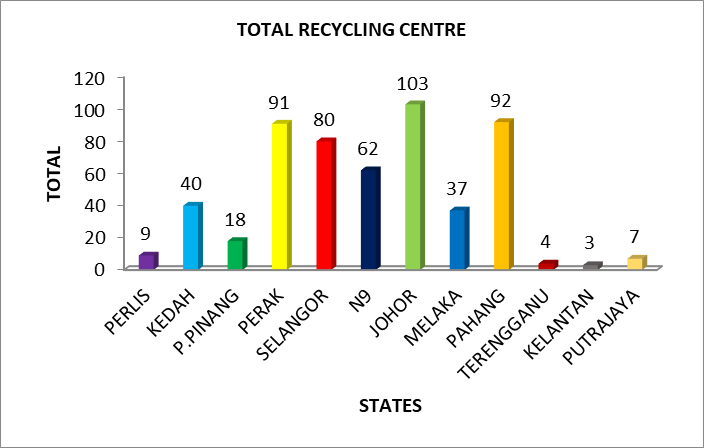
Source (correspondence with Swcorp 2017)
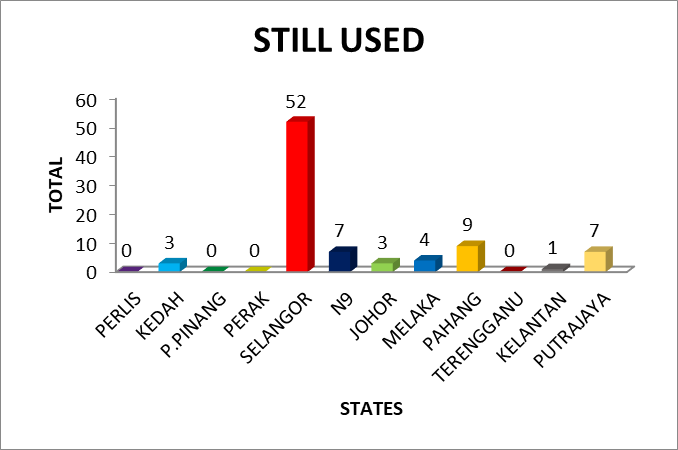
Source (correspondence with Swcorp 2017)
Thus, the government’s effort to promote sustainable solid waste management prompted the implementation of the waste separate at source programme as part of the Solid Waste Management and Public Cleansing Corporation Act 672. The act which was enforced by the Solid Waste and Public Cleansing Management Corporation (SWcorp) effective June 1st, 2016, makes it mandatory for households within the areas of jurisdiction (Federal Territory of Kuala Lumpur, Putrajaya, and states of Johor, Melaka, Negeri Sembilan, Pahang, Kedah and Perlis) to separate their waste prior to disposal (SWcorp, 2015). Failure of which will result to penalty, and failure to pay the penalty will lead to court charge with a maximum of RM1000 charge.
The remainder of this paper is organized into the following section. Section two presents the problem statement of the study. Section three presents the research questions. Section four details the purpose of the study. Section five includes the research method employed to achieve the objectives of this study. Section six present and discusses the outcome of the analysis. Lastly, section seven covers the conclusions.
Problem statement
A renewed effort to encourage recycling among the households by the Malaysian Government resulted in the implementation of the mandatory separation at source. Most studies with regards to implementation of recycling programmes in Malaysia, examined households’ intention to participate in recycling activities. However there is need to evaluate of the programmes ex-post so as to make improvements where necessary. Though the on-going separation at source programme is relatively at the infant stage, an assessment of the programme from the perspective of the household in terms of their separation activities and awareness of available recycling facilities is of utmost importance. These will provide relevant outcome of interest for purposes of programme evaluation. This study will enable a better understanding of how well the programme is performing at motivating household recycling activities. It will also provide an insight on respondents’ knowledge on available drop-off centres and its utilization.
Research question
Though the on-going waste separation at source programme is recently implemented in Malaysia, this study tries to explore to how the programme has motivated participation in recycling among the Malaysian households.
Purpose of the study
This study aims to provide an overview of the households’ participation in the waste separation at source programme, and their awareness and use of drop-off recycling centres. To achieve the aim of this study, the following objectives were pursued.
To assess the performance of the Separation at Source programme among households.
To determine if there is statistically significant difference in households recycling practices prior to and after the implementation of the separation at source programme.
To assess households awareness of and utilization of drop of recycling centres.
Research Methods
Survey Design and Location of Study
The data employed in this study comes from the administration of questionnaires conducted in Putrajaya, Malaysia in 2017. The questionnaires were administered face-face by trained enumerators to 431 households. Though the sample employed might not be a true representation of the Malaysian society, Putrajaya, Malaysia’s third Federal Territory after Kuala Lumpur and Labuan (PPJ, 2012) is a fast-growing cities with an estimated population of 67,964 and highest annual population growth rate of 17.8% as compared to state of Selangor (2.7%), Melaka (2.6%) and Sabah (2.1%), level of urbanisation was 100% for the period 2000-2010 (Census, 2010). Also, the availability of drop-off centres in Putrajaya makes it an ideal location for the study.
A stratified random sampling was used to obtain a fair representation based on the housing types including terrace, semi-detached (SD), bungalow, and townhouse. The enumerators elicited information from the households on their waste separation activities prior to and after the implementation of the separation at source programme as well as their awareness and utilization of drop off centres.
Data analysis
This paper employed descriptive statistics and Wilcoxon Signed Rank test to assess the performance of household recycling activities prior to and after the implementation of the separation at source programme among residents of Putrajaya, Malaysia. Descriptive statistics was also used to assess the respondents’ awareness and utilization of available drop-off recycling facilities. The data was analysed using IBP SPSS 23.
Findings
The analysis was performed using SPSS version 23. Descriptive statistics including Frequencies, percentages and bar charts were employed to describe the respondents’ demographic profile, waste separation activities prior to and after the implementation of the separation at source programme as well as respondents’ awareness and utilization of the drop of centres. Additionally, the Wilcoxon Signed Rank test was employed to test for difference in waste separation practices prior to and after the implementation of the waste separation at source programme. The effect size was also computed to show the magnitude of the difference.
Respondents demographics
A total of 396 of the 431 questionnaires distributed were found usable after checking for missing information. Further analysis was based on the 396 questionnaires. Information on the demographic profile of the respondents is presented in Table
Households awareness and waste separation at source activities
The descriptive statistics show that an overwhelming percentage of the respondents (97%) was aware of the separation at source programme, meanwhile, only (3%) indicated not being aware of the programme. This shows that a large proportion of households are aware of the separation at source programme. This findings further support that of Moh and Abd Manaf (2014) conclusion that, awareness of recycling activities is quite high among Malaysian households but actual participation remains low. The high level of awareness could probably be due to the effort put in by the appropriate authorities on the campaign on the implementation of the programme. Figure
![[Awareness of separation at source programme]](https://www.europeanproceedings.com/files/data/article/94/5445/AIMC2018130.fig.003.jpg)
Figure
![[Waste separation activity prior to the implementation of separation at source
programme]](https://www.europeanproceedings.com/files/data/article/94/5445/AIMC2018130.fig.004.jpg)
Figure
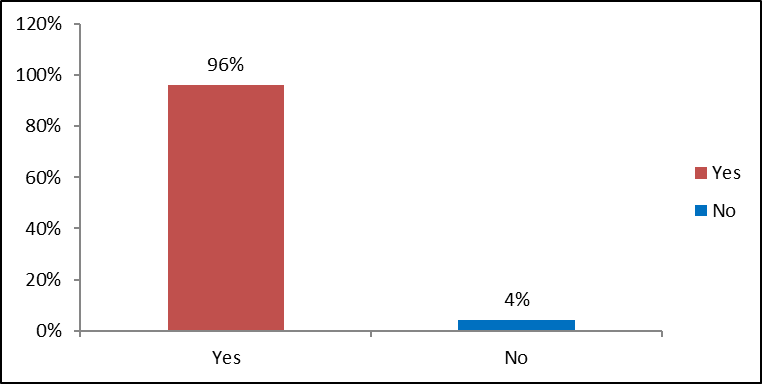
The Wilcoxon signed rank test was used to test if the difference as shown by the descriptive analysis is statistically significant. The outcome of the analysis as presented in Table
Awareness of and utilization of Drop-off recycling centres
Figure
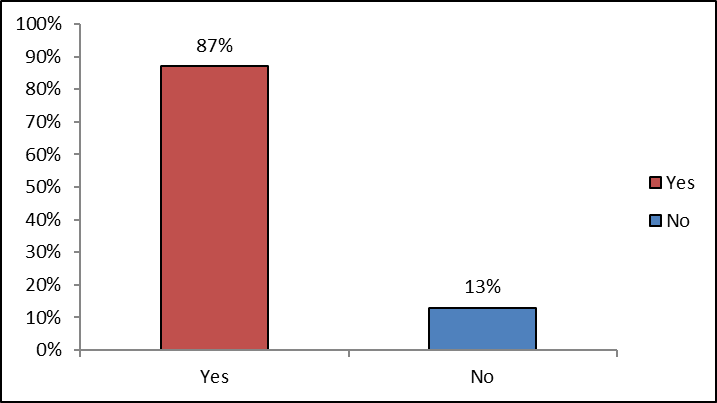
Though a significant number of respondents as depicted in Figure
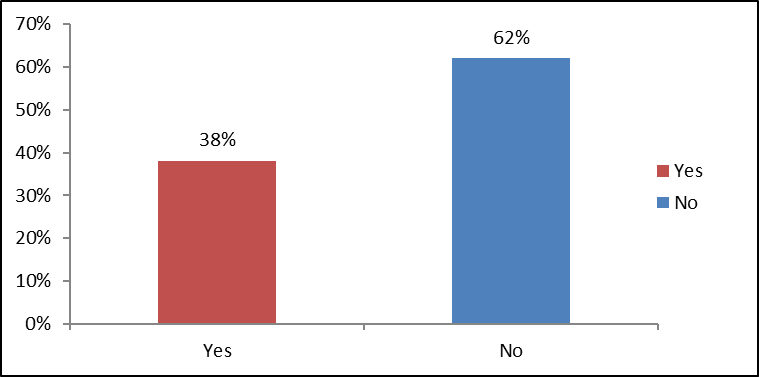
Conclusion
The study provided an analysis of household waste separation activities prior to and after the implementation of the separation at source programme and also assesses the awareness and utilization of drop-off centres by households in Putrajaya Malaysia. The aim is to assess the effectiveness of the programme from the perspective of the households. The analysis revealed statistically significant improvement in household participation in recycling through waste separation activities. Thus, successful waste separation practices at the household level can be greatly improved with full enforcement most especially at this initial stage of the programme. On the other hand, utilization of drop off centres was found to be low despite high awareness on the existence of such recycling facilities. Though the present study did not assess the factors that could be responsible for the poor utilization, it will be of great importance to assess the factors that could motivate utilization of the drop off centre. This will help to reduce the financial burden of recyclables collection and the cost of strict monitoring by relevant agencies.
Acknowledgments
The authors are grateful to Universiti Putra Malaysia for the financial support through the Award of Geran Putra (GP-IPS/9516500) that aided in the collection of data employed in the study.
References
- Abdul Jalil, M. (2010). Sustainable development in Malaysia: A case study on household waste management.
- Agamuthu, P., & Fauziah, S. (2011). Challenges and issues in moving towards sustainable landfilling in a transitory country-Malaysia. Waste Management & Research, 29(1), 13-19.
- Aphale, O., Thyberg, K. L., & Tonjes, D. J. (2015). Differences in waste generation, waste composition, and source separation across three waste districts in a New York suburb. Resources, Conservation and Recycling, 99, 19-28. doi: DOI:
- Economic Planning Unit. (2010). Tenth Malaysia Plan 2011-2015 Malaysia: Economic Planning Unit.
- EU-Asia, (2009). Sustainable Waste Management Cycle (EA-SWMC).EU-Perak Solid Waste Management Plan (EU-PSWMP), Perak, Malaysia.
- Hoornweg, D., & Bhada-Tata, P. (2012). What a waste: a global review of solid waste management.
- Japan International Cooperation Agency (JICA; JULY 2006). The Study on National Waste Minimization in Malaysia. Final Report Vol. iii pilot project
- Kalanatarifard, A., & Yang, G. S. (2012). Identification of the municipal solid waste characteristics and potential of plastic recovery at Bakri Landfill, Muar, Malaysia. Journal of Sustainable Development, 5(7), 11.
- Masirin, M., Idrus, M., Ridzuan, M. B., & Mustapha, S. (2008). An overview of landfill management and technologies: a Malaysian case study at Ampar Tenang.
- Moh, Y. C., & Abd Manaf, L. (2014). Overview of household solid waste recycling policy status and challenges in Malaysia. Resources, Conservation and Recycling, 82(0), 50-61. doi: DOI:
- Moh, Y. C., & Abd Manaf, L. (2017). Solid waste management transformation and future challenges of source separation and recycling practice in Malaysia. Resources, Conservation and Recycling, 116, 1-14. doi:
- Murad, W., & Siwar, C. (2007). Waste management and recycling practices of the urban poor: a case study in Kuala Lumpur city, Malaysia. Waste Management & Research, 25(1), 3-13. doi:
- Owusu, V., Adjei-Addo, E., & Sundberg, C. (2013). Do economic incentives affect attitudes to solid waste source separation? Evidence from Ghana. Resources, Conservation and Recycling, 78(0), 115-123. doi: DOI:
- Pek, C.-K., & Jamal, O. (2011). A choice experiment analysis for solid waste disposal option: A case study in Malaysia. Journal of environmental management, 92(11), 2993-3001. doi: DOI:
- Saphores, J.-D. M., Nixon, H., Ogunseitan, O. A., & Shapiro, A. A. (2006). Household willingness to recycle electronic waste: an application to California. Environment and behavior, 38(2), 183-208.
- Sidique, S. F., Lupi, F., & Joshi, S. V. (2010). The effects of behavior and attitudes on drop-off recycling activities. Resources, Conservation and Recycling, 54(3), 163-170.
- SWcorp. (2015). PELAN STRATEGIK SWCorp 2014-2020. SWCorp Malaysia Retrieved from http://goo.gl/J52vMN.
- Tiller, K. H., Jakus, P. M., & Park, W. M. (1997). Household willingness to pay for dropoff recycling. Journal of Agricultural and Resource Economics, 310-320.
- Zainu, Z. A., & Songip, A. R. (2017). Policies, challenges and strategies for Municipal waste management in Malaysia. Journal of Science, Technology and Innovation Policy, 3(1).
Copyright information

This work is licensed under a Creative Commons Attribution-NonCommercial-NoDerivatives 4.0 International License.
About this article
Publication Date
17 May 2019
Article Doi
eBook ISBN
978-1-80296-061-7
Publisher
Future Academy
Volume
62
Print ISBN (optional)
-
Edition Number
1st Edition
Pages
1-539
Subjects
Business, innovation, sustainability, environment, green business, environmental issues
Cite this article as:
Radam, A., Abdul Samad, A. R., Abu Talib, M., Fahmi Sidique, S., & Ogiri*, I. A. (2019). An Assessment Of Separation At Source Programme Among Households In Putrajaya, Malaysia. In M. Imran Qureshi (Ed.), Technology & Society: A Multidisciplinary Pathway for Sustainable Development, vol 62. European Proceedings of Social and Behavioural Sciences (pp. 308-318). Future Academy. https://doi.org/10.15405/epsbs.2019.05.02.30
